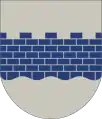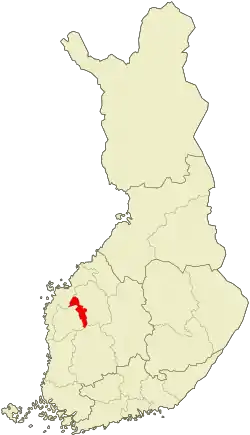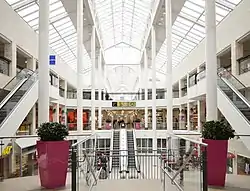Seinäjoki
Seinäjoki (Finnish: ![]() [ˈs̠e̞i̯næˌjo̞ki] ; lit. "Wall River"; Latin: Wegelia) is a city located in South Ostrobothnia, Finland; 80 kilometres (50 mi) east of Vaasa, 178 kilometres (111 mi) north of Tampere, 193 kilometres (120 mi) west of Jyväskylä and 324 kilometres (201 mi) southwest of Oulu. Seinäjoki originated around the Östermyra bruk iron and gunpowder factories founded in 1798. Seinäjoki became a municipality in 1868, market town in 1931 and town in 1960. In 2005, the municipality of Peräseinäjoki was merged into Seinäjoki, and in the beginning of 2009, the neighbouring municipalities of Nurmo and Ylistaro were consolidated with Seinäjoki. Seinäjoki is one of the fastest growing regional centers in Finland.[6]
[ˈs̠e̞i̯næˌjo̞ki] ; lit. "Wall River"; Latin: Wegelia) is a city located in South Ostrobothnia, Finland; 80 kilometres (50 mi) east of Vaasa, 178 kilometres (111 mi) north of Tampere, 193 kilometres (120 mi) west of Jyväskylä and 324 kilometres (201 mi) southwest of Oulu. Seinäjoki originated around the Östermyra bruk iron and gunpowder factories founded in 1798. Seinäjoki became a municipality in 1868, market town in 1931 and town in 1960. In 2005, the municipality of Peräseinäjoki was merged into Seinäjoki, and in the beginning of 2009, the neighbouring municipalities of Nurmo and Ylistaro were consolidated with Seinäjoki. Seinäjoki is one of the fastest growing regional centers in Finland.[6]
Seinäjoki | |
|---|---|
City | |
| Seinäjoen kaupunki Seinäjoki stad | |
 Top: Panorama view of Seinäjoki from the Jouppilanvuori hill, 2nd: Torikeskus Street and Koulukatu area, 3rd left: Lakeuden Risti Church, 3rd upper right: Aalto Center (Aaltokeskus), 3rd lower right: Lakeuden Risti Park, Bottom: View of downtown Seinäjoki from Alvar Aalto Tower | |
 Coat of arms | |
 Location of Seinäjoki in Finland | |
| Coordinates: 62°47.5′N 022°50.5′E | |
| Country | |
| Region | South Ostrobothnia |
| Sub-region | Seinäjoki sub-region |
| Charter | 1868 |
| Market town | 1931 |
| Town | 1960 |
| Government | |
| • City manager | Jaakko Kiiskilä |
| Area (2018-01-01)[1] | |
| • City | 1,469.23 km2 (567.27 sq mi) |
| • Land | 1,431.64 km2 (552.76 sq mi) |
| • Water | 37.59 km2 (14.51 sq mi) |
| • Urban | 52.78 km2 (20.38 sq mi) |
| Area rank | 48th largest in Finland |
| Population (2020-07-31)[2] | |
| • City | 63,961 |
| • Rank | 16th largest in Finland |
| • Density | 44.68/km2 (115.7/sq mi) |
| • Urban | 46,639 |
| • Urban density | 883.6/km2 (2,289/sq mi) |
| Population by native language | |
| • Finnish | 98.7% (official) |
| • Swedish | 0.2% |
| • Others | 1.1% |
| Population by age | |
| • 0 to 14 | 18.3% |
| • 15 to 64 | 66.8% |
| • 65 or older | 15% |
| Time zone | UTC+02:00 (EET) |
| • Summer (DST) | UTC+03:00 (EEST) |
| Municipal tax rate[5] | 19.25% |
| Website | www.seinajoki.fi |

The city hall, city library, Lakeuden Risti Church and other public buildings were designed by Alvar Aalto.
The asteroid 1521 Seinäjoki bears the town's name.
Seinäjoki was historically called Östermyra in Swedish. Today this name, which never was official, is very seldom used even among the Swedish speakers.
Seinäjoki Airport is located in the neighbouring municipality of Ilmajoki, 11 kilometres (10 mi) south of the Seinäjoki city centre. Seinäjoki railway station in city center was opened in 1883 and until 1897 it carried the name Östermyra station.
History
The settlement spread in the area of the present Seinäjoki during the first half of the 16th century. During the 1550s, there is said to have been three houses in Seinäjoki: the houses of Marttila, Jouppi and Uppa. The house of Jouppila, which separated from the house of Jouppi, was established during the same century. All of the houses were located on the shore of the river.
Seinäjoki belonged to the church parish of Ilmajoki like Kurikka, Kauhajoki, Jalasjärvi and Alavus. However, in the 18th century the roads from Seinäjoki to the Church of Ilmajoki were generally in poor condition. Therefore, the inhabitants of Seinäjoki and the neighbouring Nurmo built a new chapel together in 1725, which in 1765 led to the formation of the chapel town of Nurmo. Seinäjoki, which was called Alaseinäjoki since the Greater Wrath, became a part of the chapel town. The chapel parish of Peräseinäjoki was founded in 1798, and the village of Alaseinäjoki began to be called Seinäjoki again. The very same year, the Östermyra steel mill was founded on the shore of the Seinäjoki river.
In the 1850s, actions were taken to separate Seinäjoki from the church parish of Nurmo. Ilmajoki wanted to connect Seinäjoki back to its own parish. In spite of strong objections from the inhabitants of Nurmo, the Senate of Finland accepted the petition from the inhabitants of Seinäjoki in 1863, to form a chapel congregation of their own. Seinäjoki got an independent local government in 1868. In 1900, Seinäjoki became an independent municipality.
Seinäjoki has grown around a few important railroad crossings. The Tampere–Vaasa railway, which passes through Seinäjoki, was inaugurated in 1883. The track, along with the Kokkola track that was opened for rail service in 1885, and the Kristinestad track which had been completed in 1913, raised Seinäjoki as an important railway crossing section in Finland. In the early 1970s, a direct railway between Tampere and Seinäjoki was opened, and the services of Seinäjoki improved further.
After the Winter War and Continuation War, some refugees from Jaakkima and Lumivaara were resettled to Seinäjoki.
Geography
The neighboring municipalities of Seinäjoki are Kauhava in the north, Lapua in the northeast, Kuortane and Alavus in the east, Virrat and Kihniö in the south, Ilmajoki and Kurikka in the west and Isokyrö in the northwest.
The proportion of water in the Seinäjoki landscape is small. Seinäjoki River flows through the city in a south-east-northwest direction and turns at the northern border of the city center, connecting with the Kyrönjoki River,[7] which flows into the Gulf of Bothnia in the Vaasa area.
The most significant road connections in Seinäjoki are highways 16, 18 (between cities of Vaasa and Jyväskylä), 19 and 67.
Culture
There are many kinds of cultural events in Seinäjoki nowadays. For example, Seinäjoki is known for hosting three large summer events: Tangomarkkinat, which is a tango festival typically attracting more than 100,000 visitors annually, Vauhtiajot, which is a motor racing event/music festival, and Provinssirock, which is one of the largest and oldest rock festivals in Finland. Rytmikorjaamo is a popular rock club, wherein almost every weekend some Finnish or international artists perform. In Seinäjoki there are also several other bars and clubs offering live music and other entertainment. The city theatre of Seinäjoki has a wide, quality program throughout the year, offering plays for everyone. The city orchestra of Seinäjoki performs many concerts in the area and has had many tours in Finland and abroad.
Sports
Seinäjoki is home to a big number of sports clubs, such as SJK Seinäjoki, a professional football team that competes in the Finnish Veikkausliiga. SJK is one of the top football teams in Finland and it plays in the brand new OmaSp Stadion. Seinäjoki is also home to Seinäjoki Crocodiles, an American football team.
Sights
- Lakeuden Risti Church ("The Cross of the Plains")
- Alvar Aalto's cultural and administrative centre, comprising the City Hall, library and theatre, among others
- The Southern Ostrobothnia District Museum
- The Civil Guard and Lotta Svärd museum
- Törnävä church
- The railway exhibition
- Mallaskoski brewery
Other points of interest
Notable people
- Jukka Hildén, stuntman, The Dudesons
- Antti Isotalo, jäger, tribal warrior, Alko's local leader
- Katja Kankaanpää, mixed martial artist
- Mari Kiviniemi, politician (Prime Minister of Finland 2010—2011)
- Paula Koivuniemi, singer
- Petri Kontiola, hockey player
- Pekka Koskela, speed skater
- Jarno Laasala, stuntman, The Dudesons
- Hannu Lahtinen, world wrestling champion
- Veli Lampi, soccer player
- Jarppi Leppälä, stuntman, The Dudesons
- Tapio Luoma, Archbishop
- Jorma Ollila, former Chairman and CEO of the Nokia Corporation
- Hannu-Pekka "HP" Parviainen, snowboarder, stuntman, The Dudesons
- Pekka Puska, public health researcher and official
- Paula Risikko, Member of Parliament and Minister
- Arto Saari, skateboarder
- Softengine, rock pop band
Statistics
- Population: 31,696 (2003), 35,918 (2005 after consolidation with Peräseinäjoki) and 56,229 (2009 after consolidation with Nurmo and Ylistaro).
- Annual growth: 624
Economy

Nordic Regional Airlines has its financial office in Seinäjoki.[8] Its predecessor, Finncomm Airlines, had its head office on the grounds of Seinäjoki Airport in nearby Ilmajoki.[9]
In terms of market area, Seinäjoki is the sixth largest city in the country.[10] Also Seinäjoki has a nationally and internationally significant food production and R&D industry. Headquartered in Seinäjoki food company Atria Corporation's net sales in 2009 were EUR 1316 million and it employed an average of 6,214 persons in several countries. According to a study published by the Economic Survey at the end of 2018, Seinäjoki has the best image among corporate leaders among the 36 largest Finnish cities and municipalities. The survey had asked the CEOs and CFOs of companies operating in the area about the municipality's affairs.[11]
Seinäjoki also is well known for having a large number of SME's and a big number of shops for its size. One of the most important shopping places in Seinäjoki is the Torikeskus shopping mall in the city center.
Education
Seinäjoki University of Applied Sciences (SeAMK) is the local higher education institution, that also pursues an international profile.
International relations
Twin towns — Sister cities
See also
Sources
Literatures
- Reino Ala-Kulju (1963). Seinäjoen kirja (in Finnish). Seinäjoen seurakunta.
- Aulis J. Alanen (1970). Seinäjoen historia I (in Finnish). Seinäjoen kaupunki.
- Annikki Kyttä & Tenho Takalo (1977). Seinäjoen historia II (in Finnish). Seinäjoen kaupunki. ISBN 951-99131-5-7.
References
- "Area of Finnish Municipalities 1.1.2018" (PDF). National Land Survey of Finland. Retrieved 30 January 2018.
- "Suomen virallinen tilasto (SVT): Väestön ennakkotilasto [verkkojulkaisu]. Heinäkuu 2020" (in Finnish). Statistics Finland. Retrieved 13 September 2020.
- "Population according to language and the number of foreigners and land area km2 by area as of 31 December 2008". Statistics Finland's PX-Web databases. Statistics Finland. Retrieved 29 March 2009.
- "Population according to age and gender by area as of 31 December 2008". Statistics Finland's PX-Web databases. Statistics Finland. Retrieved 28 April 2009.
- "List of municipal and parish tax rates in 2011". Tax Administration of Finland. 29 November 2010. Retrieved 13 March 2011.
- Knuuttila, Jussi (2005). "Maaseutuvirasto Seinäjoelle Hallintobyrokratia siirtyy keskelle vahvaa yrittäjäseutua" (in Finnish). Maatilan Pellervo. Retrieved November 16, 2020.
- Reino Ala-Kulju (1963). Seinäjoen kirja (in Finnish). Seinäjoen seurakunta.
- "About Us." Nordic Regional Airlines. Retrieved on October 25, 2016.
- "Contact Information." Finncomm Airlines. Retrieved on 25 February 2010.
- "Kauppa-Joupin asemakaavoitus, Kaupallisten ja sosiaalisten vaikutusten arviointi" (PDF). Entrecon (in Finnish). Seinäjoen kaupunki. May 10, 2010. Retrieved November 16, 2020.
- "Seinäjoella on paras imago" (in Finnish). Taloustutkimus (taloustutkimus.fi). December 11, 2018. Retrieved November 16, 2020.
- "Ystävyyskaupungit" (in Finnish). City of Seinäjoki. Retrieved 22 August 2019.
Notes
External links

![]() Media related to Seinäjoki at Wikimedia Commons
Media related to Seinäjoki at Wikimedia Commons
 Seinäjoki travel guide from Wikivoyage
Seinäjoki travel guide from Wikivoyage- Seinäjoki – Official website
- Provinssirock – rock festival
- Tangomarkkinat – tango festival
